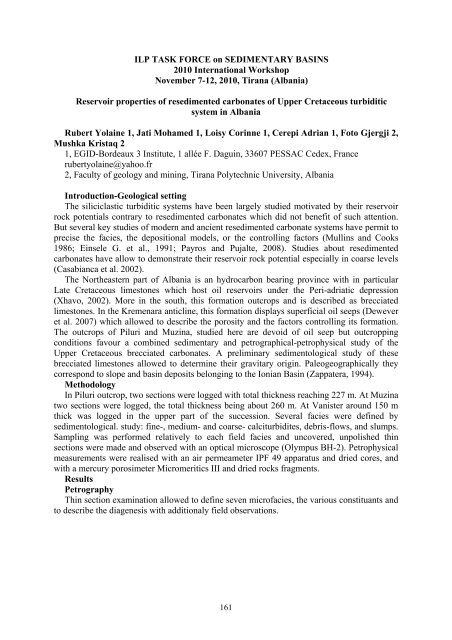DYNAMICS and ACTIVE PROCESSES - International Lithosphere ...
DYNAMICS and ACTIVE PROCESSES - International Lithosphere ...
DYNAMICS and ACTIVE PROCESSES - International Lithosphere ...
Create successful ePaper yourself
Turn your PDF publications into a flip-book with our unique Google optimized e-Paper software.
ILP TASK FORCE on SEDIMENTARY BASINS<br />
2010 <strong>International</strong> Workshop<br />
November 7-12, 2010, Tirana (Albania)<br />
Reservoir properties of resedimented carbonates of Upper Cretaceous turbiditic<br />
system in Albania<br />
Rubert Yolaine 1, Jati Mohamed 1, Loisy Corinne 1, Cerepi Adrian 1, Foto Gjergji 2,<br />
Mushka Kristaq 2<br />
1, EGID-Bordeaux 3 Institute, 1 allée F. Daguin, 33607 PESSAC Cedex, France<br />
rubertyolaine@yahoo.fr<br />
2, Faculty of geology <strong>and</strong> mining, Tirana Polytechnic University, Albania<br />
Introduction-Geological setting<br />
The siliciclastic turbiditic systems have been largely studied motivated by their reservoir<br />
rock potentials contrary to resedimented carbonates which did not benefit of such attention.<br />
But several key studies of modern <strong>and</strong> ancient resedimented carbonate systems have permit to<br />
precise the facies, the depositional models, or the controlling factors (Mullins <strong>and</strong> Cooks<br />
1986; Einsele G. et al., 1991; Payros <strong>and</strong> Pujalte, 2008). Studies about resedimented<br />
carbonates have allow to demonstrate their reservoir rock potential especially in coarse levels<br />
(Casabianca et al. 2002).<br />
The Northeastern part of Albania is an hydrocarbon bearing province with in particular<br />
Late Cretaceous limestones which host oil reservoirs under the Peri-adriatic depression<br />
(Xhavo, 2002). More in the south, this formation outcrops <strong>and</strong> is described as brecciated<br />
limestones. In the Kremenara anticline, this formation displays superficial oil seeps (Dewever<br />
et al. 2007) which allowed to describe the porosity <strong>and</strong> the factors controlling its formation.<br />
The outcrops of Piluri <strong>and</strong> Muzina, studied here are devoid of oil seep but outcropping<br />
conditions favour a combined sedimentary <strong>and</strong> petrographical-petrophysical study of the<br />
Upper Cretaceous brecciated carbonates. A preliminary sedimentological study of these<br />
brecciated limestones allowed to determine their gravitary origin. Paleogeographically they<br />
correspond to slope <strong>and</strong> basin deposits belonging to the Ionian Basin (Zappatera, 1994).<br />
Methodology<br />
In Piluri outcrop, two sections were logged with total thickness reaching 227 m. At Muzina<br />
two sections were logged, the total thickness being about 260 m. At Vanister around 150 m<br />
thick was logged in the upper part of the succession. Several facies were defined by<br />
sedimentological. study: fine-, medium- <strong>and</strong> coarse- calciturbidites, debris-flows, <strong>and</strong> slumps.<br />
Sampling was performed relatively to each field facies <strong>and</strong> uncovered, unpolished thin<br />
sections were made <strong>and</strong> observed with an optical microscope (Olympus BH-2). Petrophysical<br />
measurements were realised with an air permeameter IPF 49 apparatus <strong>and</strong> dried cores, <strong>and</strong><br />
with a mercury porosimeter Micromeritics III <strong>and</strong> dried rocks fragments.<br />
Results<br />
Petrography<br />
Thin section examination allowed to define seven microfacies, the various constituants <strong>and</strong><br />
to describe the diagenesis with additionaly field observations.<br />
161




